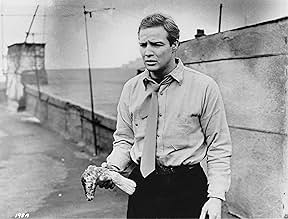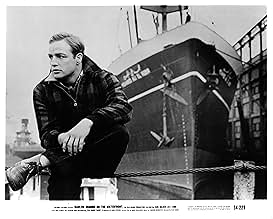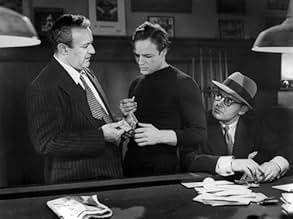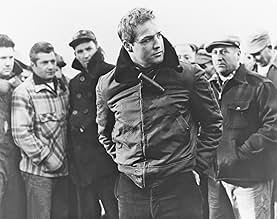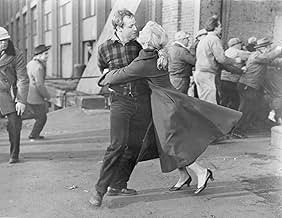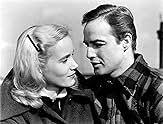Ein ehemaliger Preisboxer und Hafenarbeiter kämpft darum, seinen korrupten Gewerkschaftsbossen standzuhalten.Ein ehemaliger Preisboxer und Hafenarbeiter kämpft darum, seinen korrupten Gewerkschaftsbossen standzuhalten.Ein ehemaliger Preisboxer und Hafenarbeiter kämpft darum, seinen korrupten Gewerkschaftsbossen standzuhalten.
- 8 Oscars gewonnen
- 30 Gewinne & 11 Nominierungen insgesamt
- 'Pop' Doyle
- (as John Hamilton)
- Gillette
- (Nicht genannt)
- Sidney
- (Nicht genannt)
Zusammenfassung
Empfohlene Bewertungen
The curtain opens with Terry working for Johnny Friendly to be participated in a murder. He does his duty and the murder takes effect. The victim was a labor, whose labor leader also works for Johhny Friendly. Terry turns gloomy when he finds out that the victim has been only seeking his rights when he became a rebel. Especially when Terry meets with the victim's sister his suspects grew. She reasons with him that there are two opposite sides: Johnny Friendly's rich and still-growing syndicate versus the dependent and needy workers who are driven into Johnny Friendly's punitive sanctions. Provided that Terry finds a third side: His own.
A run of the mill plot of the mid-20th century. Everybody is pretty much familiar with labor union issues. Mainly the subject gives nothing more than workers seeking out their rights. However, consider that it's Elia Kazan who ushers a new era of actors who rage the whole scenes and turn out heroes out of bums. On the Waterfront has surely inspired millions. For instance, in Robert De Niro's "Raging Bull", a prize-fighter like Terry Malloy turns out to be a stage actor and affirms Terry's speech of reproach to his brother, where no other words could describe his situation he fell into.
Marlon Brando's can-do attitude created an inspirational movement, imprinting our memory, that "If Terry Malloy can do this, yes; I can do this, and yes; everybody can do this". Subsequently movie makers began to deliver efforts and accomplishments to the silver screen in order to catch viewers' appreciations. On The Waterfront, Elia Kazan and Marlon Brando are those to remember together in the motion picture history.
Unquestionably, the strength of the film is the acting. Brando's performance in particular is one for the ages. He won his first Oscar for this role and Eva Marie Saint also garnered an Oscar in her introductory film role. On top of that Karl Malden, Lee J. Cobb & Rod Steiger all earned Best Supporting Actor nominations. These accolades give an idea of the level of talent on display here.
Kazan's direction is well done as he strives for a gritty, realistic look. Shooting on location was an important part of that. Leonard Bernstein's score, on the other hand, is often overbearing. There's nothing wrong with the music itself, only the prominence of it.
The main area in which I feel the film doesn't quite deliver is the story. The film does a fine job of exploring the characters but I find that the underlying storyline doesn't really work for me. The main premise is a good one but after the initial confrontation I began to lose interest. The self-consciously 'inspiring' ending doesn't help, either.
All things considered, I give the film high marks for the excellent acting and direction which, unfortunately, are in service of a merely average story.
His brother Charley (Rod Steiger), a suave opportunistic lawyer, works for the local dockers' union, headed by Johnny Friendly (Lee J. Cobb), the arrogant mob boss
Friendly takes affectionate interest in Terry and tries to make things easy for him He also takes advantage of Terry by involving him in the killing of an uncooperative docker Unaware of their murderous intentions, Terry sets the trap for the man who is thrown from a roof top because he allowed himself to be interviewed by a crime investigating commission
Terry's alienation from the crooked union leaders starts when he meets the dead man's sister, Edie (Eva Marie Saint), and realizes the grief he has brought into her life She asks his help in bringing the racketeers to justice, as does Father Barry (Karl Malden), a priest of complete goodness and rightness
Brando's moral dilemma was superbly drawn in the film He's an ordinary man finding the courage to stand up and be counted As portrayed by Brando he is touchingly believable
The rest of the cast is excellent:
Cobb is extremely good as the brute fury boss who intimidates the workers into silence, stopping at nothing to maintain his position of power on the docks...
Rod Steiger gives his finest performance as the clever and suave opportunistic lawyer who works for the local docker's union...
Eva Marie Saint manages to make the blood go through Brando's valves reviving and creating a heart that never existed before...
Karl Malden is hard and clear as the activist Catholic priest who continue encouraging other longshoremen to testify, inciting Brando to fight for his rightsregardless of the costrather than be a pawn in a ruthless system of bribes and killings...
"On the Waterfront" is one of the great American films, not only because it bravely spreads a strong light on the violation of justice, but because it is a powerful piece of cinema, which push forward a classic study of man's responsibility to his fellow man...
The film won eight Academy Awards...
In the most famous scene, Brando, a has-been prizefighter, confronts his brother (Steiger) who is about to set him up to be executed by the mob bosses of the union. When Steiger reveals his intent to set Brando up, the scene explodes with reality and pathos. Brando's words, "Wow", sum up the intensity and emotion of the scene.
Great acting and directing, however, cannot cover up the transparent political/apologetical intent of the movie. Two years earlier, Kazan had sold out his integrity to the House Unamerican Affairs Committee (HUAC), "naming names" of those who would become the blacklisted Hollywood 10. Kazan, a former communist himself, regretted his involvement with the Party, and evidently decided it was politically advantageous to name his former associates. Likewise, Brando character Malloy finds himself in a mob-run labor union, and in his effort to 'get out', repeats much of what Kazan did in real life. Worse, Kazan, through the allegorical message of the film, brands his former writers as criminals and murders, and himself as the naive innocent. Being a communist was no crime in the 30s, and he was no innocent.
"On the Waterfront" is thus steeped in a right-wing political worldview. Mobs run labor unions. Unions are thus corrupt organizations who exploit workers and make it harder for businesses to thrive. Turn in union leaders into the police. Even the church becomes a tool of the state to further the cause of the police against the union.
Brando was never satisfied with "On the Waterfront". In fact, he later commented that it was indeed a tool for Kazan to justify his actions to the HUAC. One thumb up for the acting, one thumb down for the cheap political message.
It made a moviefan of me for life. I remember the effect of "On the Waterfront", as I remember thinking about Terry Malloy in that final scene, "Wow, that guy's got guts! I wish I could be like him." Being just a typical Midwestern teen, I didn't know who Marlon Brando was, but I just was fascinated by this life of these good and bad people, on the tops of buildings and in the cold, wet streets and alleys of this far-away place near the waterfront.
Now, every time I watch it, years later, I still love it. Yes, there is definitely an attempt to make Terry into a Christ-figure at the end. That's no coincidence that he stumbles from having been beaten to a pulp, to walk and carry a hook on his shoulders, to lead others to a better life. (In the book by Budd Schulberg, by the way, Terry disappears after testifying and what is thought to be his body is found floating in a barrel of lime. But he has become a legend on the waterfront.) I love the powerful Elmer Bernstein score (glaring for our present tastes, but back then, exactly what people expected to hear during a drama -- you've got to wonder what a future generation will say about the constant replays of fairly irrelevant pop and rap songs as themes during most movies today, dramatic or comedy).
And being raised in a Catholic home, I found Father Barry to be a great dramatic figure, one of the only times I saw a priest portrayed as a gritty, brave, heroic person, not afraid to mix it up with the common folks in the parish. He smoked, drank and slugged it out. And he was not afraid to die for the right reason. Folks, that's true Christianity at work. And that's powerful.
A classic. A must-see. 10/10
Oscars Best Picture Winners, Ranked
Oscars Best Picture Winners, Ranked
Wusstest du schon
- WissenswertesIn his biography of Elia Kazan, Richard Schickel describes how Kazan used a ploy to entice Marlon Brando to do the movie. He had Karl Malden direct a scene from the film with an up-and-coming fellow actor from the Actors Studio playing the Terry Malloy lead role. They figured the competitive Brando would not be eager to see such a major role handed to some new screen heartthrob. The ploy worked, especially since the competition had come in the form of a guy named Paul Newman.
- PatzerWhen Father Barry (Karl Malden) gets hit in the head with a beer can, he gets a cut on his forehead, which bleeds visibly in the scene. In subsequent scenes, there is no sign of the cut or of a bandage to show that he had been hurt.
- Zitate
Charley Malloy: Look, kid, I... how much you weigh, son? When you weighed 168 pounds you were beautiful. You coulda been another Billy Conn, and that skunk we got you for a manager, he brought you along too fast.
Terry Malloy: It wasn't him, Charley, it was you. Remember that night in the Garden you came down to my dressing room and you said, "Kid, this ain't your night. We're going for the price on Wilson." You remember that? "This ain't your night"! My night! I coulda taken Wilson apart! So what happens? He gets the title shot outdoors on the ballpark and what do I get? A one-way ticket to Palookaville! You was my brother, Charley, you shoulda looked out for me a little bit. You shoulda taken care of me just a little bit so I wouldn't have to take them dives for the short-end money.
Charley Malloy: Oh, I had some bets down for you. You saw some money.
Terry Malloy: You don't understand. I coulda had class. I coulda been a contender. I coulda been somebody, instead of a bum, which is what I am, let's face it. It was you, Charley.
- Crazy CreditsOpening credits are shown over a bamboo-type mat background.
- Alternative VersionenCriterion Collection Blu-ray Disc release exhibits the film in 1.66:1, which is widely regarded to be the "correct" aspect ratio for the film. However, a second disc includes the film in 1.33:1 AND 1.85:1, so that viewers can watch the film in the different ratios.
- VerbindungenEdited into Elia Kazan, vom Outsider zum Oscarpreisträger (2018)
Top-Auswahl
Details
- Erscheinungsdatum
- Herkunftsland
- Sprachen
- Auch bekannt als
- Nido de ratas
- Drehorte
- St Peter and St Paul Church - 400 Hudson Street, Hoboken, New Jersey, USA(interiors: church)
- Produktionsfirma
- Weitere beteiligte Unternehmen bei IMDbPro anzeigen
Box Office
- Budget
- 910.000 $ (geschätzt)
- Weltweiter Bruttoertrag
- 3.768 $
- Laufzeit1 Stunde 48 Minuten
- Farbe
Zu dieser Seite beitragen



